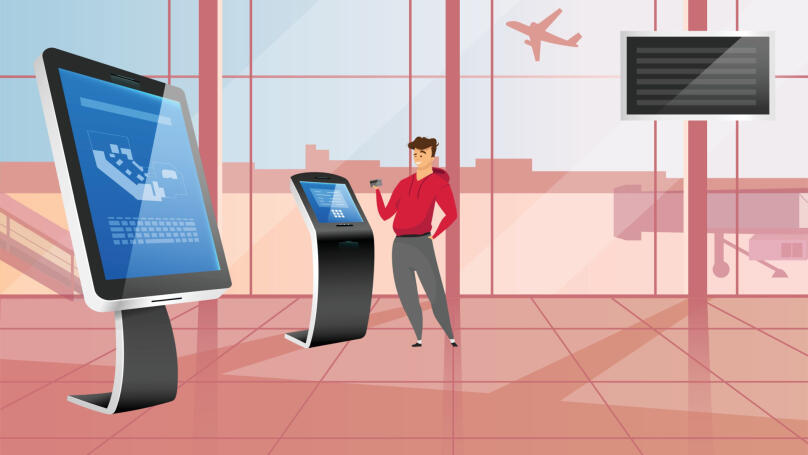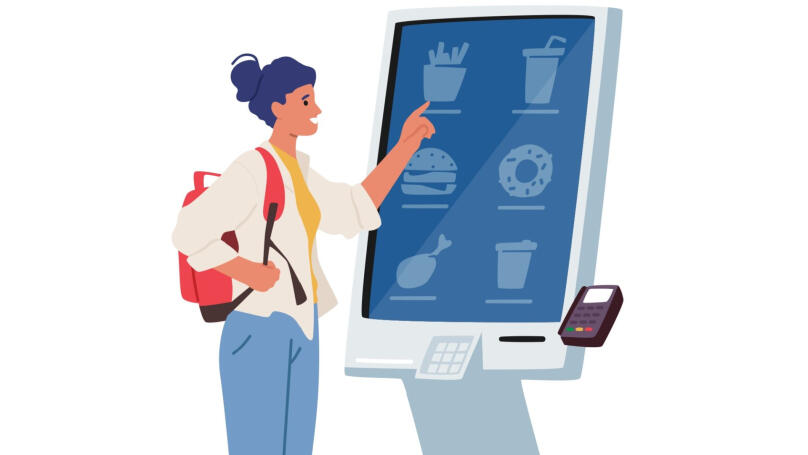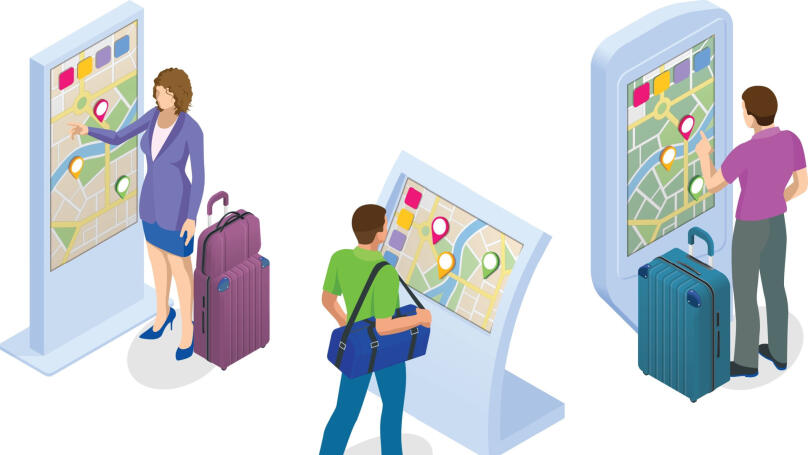Digital Signage

What is digital signage?
The term digital signage refers to any display that broadcasts information through media, screens, or any other digital signage display where advertising is done. Such multimedia banners can be seen at bus stops, shopping centers, restaurants, hotels, cinemas, train stations, and airports. Advertisers have the potential to reach potential customers about their new products and services, or simply inform them about any promotions and invite them to visit their local store.
Thus, digital signage is used in a variety of areas. This is largely due to the trends in the digitalization of social and urban spaces. Digital signage allows the public to receive information in the most convenient and comfortable way possible. It can also make it easier to navigate a room or to quickly find the information you need. In addition, some displays can not only broadcast information, but also accept payments, scan QR codes, print receipts, and respond to other consumer requests.
However, the key tasks of digital signage are:
-
Informing. Providing users, visitors, or customers with the information they need about a company, discount program, or their place in line;
-
Advertising. Attracting the customer's attention through the use of digital signage advertising, with the ultimate goal of increasing sales;
-
Entertainment. Most people visit stores and shopping centers not only out of necessity but also to relax and be distracted. Also, displaying entertainment content helps involve the customer in the shopping process, and possibly even mitigate any negative experience they may have. This is especially relevant in airports and other transportation hubs;
-
Image creation. Digital signage systems can help create a brand image in the mind of the consumer.
What are the advantages of digital signage?

The main benefits of digital signage include:
- High efficiency
A brighter and more visual information display using digital screens attracts more attention and provides the best coverage of an area. In addition, it helps to increase brand awareness and customer loyalty.
- Flexibility
Banners allow you to quickly make changes to the content. This makes it possible to adapt information to a specific audience at different times of the day. You can also make personalized offers to your customers. This will increase the level of trust in the brand and help to create strong emotional bonds between your customers and the company.
- Economy and profitability
The use of digital screens can significantly reduce the cost of printing and distributing promotional materials. In fact, digital signage can even completely replace traditional marketing methods. At the same time, digital signs help increase interest in specific products and, as a result, increase sales and profits.
- Easy calculation of statistical data
When you use digital signage you can track statistics such as the number of views. This allows you to evaluate the effectiveness of advertising and draw conclusions about how appropriate it is. You can also determine which offers are most relevant to customers, and what are not. So, it has become one of the most popular marketing tools available today because of the many benefits of digital signage. In addition, digital display manufacturers are also constantly improving their technology, which will undoubtedly open up new business opportunities.
Types of digital signage

Digital signage can be used both to provide public information, attract customers, create an image in a mass audience, and for internal communication. Therefore, depending on the goals of digital signage, there are two main types:
-
Corporate digital signage
Digital signage can be a great way to communicate in large organizations and interact across different departments. Corporate digital signage can display a variety of different things such as company news, project updates, and work calendars. It can also be used to send invitations to meetings or conferences, as well as any other information that may be useful to employees.
Digital signage can also be used in a company to distribute instructions on the proper use of technology and equipment. In addition, if digital signage has an interesting design, it might help foster a creative atmosphere in the office. To do this, photographs and other visual elements can be displayed. Digital signage is also very commonly used in conference rooms where they hold large meetings, seminars, and various other events. This not only contributes to quick and effective interaction, but also increases the morale of the employees, improves the psychological climate in the team, and sets an overall good working mood.
-
Digital board for potential clients
However, most often digital signage is used specifically to promote the brand in the media space and attract new customers. Here are some examples categorized by the information that they offer:
-
Promotions
Digital signage is usually used to communicate information about new products and services, but it's also a great way to announce promotions and sales. Since the possibilities of multimedia screens are quite versatile, advertisers can include more than just static advertising in digital signage content. They can also include video reviews of satisfied customers, offers of discounted goods, and so on. That is why digital signage is so common in the lobbies of large shopping centers, for example.
-
Services offered
Quite frequently, digital signs can be found in cafés or fast food restaurants. Although a classic paper menu is still quite common, many establishments are implementing digital signage. For example, McDonald's, the world's largest fast-food restaurant chain, uses displays to order and pay for food. In addition, restaurants, spas, medical centers, hospitals, fitness clubs, and banks can all post useful information for their customers about any offers, lists of services offered, new products, and so on.
-
Calendars and schedules of events
Any institution can use digital signage to display a schedule of events. At the same time, such use of digital signage can be useful for both employees and their visitors. Of course, digital calendars and schedules for schools, cinemas, theme parks, museums, and so on are the most common. This allows visitors to keep abreast of the day-to-day activities of institutions, their schedules, and workload levels, which, in turn, saves time for staff who do not have to answer additional questions from visitors.
-
Maps
Many large companies with multiple locations or branches specifically develop their own static maps to help guide people to reach them. The same digital maps can often be found in shopping or business centers. They are quite reliable and versatile while being affordable, easy to install, and convenient for visitors to use.
-
Inspirational content
Digital signage does not have to be direct advertising. Very often, well-known motivating or inspiring quotes are shown on the screens. Of course, they also influence the subconscious of people, and in most cases persuade them to make a purchase. These can be quotes like, "It's better to do it and regret it once, than not do it at all and regret it for the rest of your life". Or, "Let's make this world a better place!" You can also use such digital signage not only in public places to attract customers, but also in work areas to increase your employees' concentration and productivity and create a generally favorable business environment.
-
Interactive forms and games
Digital signage does not have to carry any information or semantic load. With the help of digital signage, people can escape the boredom of stores and play a game on the display. This is especially true for those who hate shopping but are forced to go with a friend or spouse. Thanks to the interactive capabilities of digital signage, you can pass time with ease. In addition, it is more convenient for some users to independently select only the content they are interested in, and not consume every media product on offer. It also ensures the interactivity of digital signage.
-
Emergency messages
Digital signage or screens can be useful if you need to urgently notify visitors of a shopping mall or any other establishment about something important. With digital signage, you can create a comprehensive emergency communication plan and regularly update the information on every screen over a huge area. In this case, important messages relating to safety or an emergency situation can be distributed quickly and efficiently.
How digital signage works

Digital signage consists of three key components: digital signage software, hardware, and content. Let's take a closer look at each component.
-
Software
What is the meaning of a CMS (Content Management System)? In short, it is a digital infrastructure which allows you to create, process, broadcast, and manage content. There are many specialized programs for digital signage on the software market today. They offer many options and additional functions, depending on the purpose of the content you are broadcasting. But any universal software should include:
-
Programs for remote content management and a screen time schedule, as well as screen network monitoring;
-
Programs for analyzing and reporting on the performance of a network of screens;
-
Applications for creating and editing content, including graphics, video, audio, and text materials;
-
Programs for interactive screens and touch panels;
-
Additional tools and plug-ins to cooperate with other applications and systems.
For example, Yodeck is considered one of the best software products available today for digital signage. They offer both paid and unpaid plans. The developers at Yodeck provide their customers with the most modern and innovative way to promote their brands through high-resolution digital signage using ultra-fast technology. Other trusted platforms for streaming and viewing content in public places include Liqvid, OptiSigns, Raydiant, and many more. All of these programs offer the most common tools, as well as special templates. In any case, each program must meet the following characteristics: allow users to easily control content and gadgets connected to the screens, automate the playback of content on the display, and provide an interactive experience. The most modern digital signage is able to determine the age and gender of a person and, therefore, divide users into certain segments. This allows the software the ability to analyze data and collect other information.
-
Digital signage hardware
These are the devices on which the information is displayed. They include:
-
Screens, monitors, plasma panels, LED displays, and projectors - all of them with different sizes, resolutions, and image quality. The most common are multitouch screens. They allow several users to simultaneously interact with the broadcast content. For example, information kiosks where customers can search for the location of a store in a huge shopping center;
-
Computers, tablets, and mobile devices that have media players with software platforms that allow you to work with digital signage and its content;
-
Network equipment, routers, and Wi-Fi hotspots that ensure the smooth operation of digital signage;
-
Structures and fixtures for mounting screens on walls, ceilings, racks, and other surfaces.
Additional equipment includes sound systems, cameras, motion sensors, QR code scanners, and other elements that can be used in digital signage to enrich the user experience.
-
Content for digital signage
What is the meaning of content? It includes all information that is displayed on a digital screen. It can be in text or graphic form, often on digital signage there is video, audio, or even animated pictures. Some examples of content are:
-
Advertising messages that are aimed at promoting goods and services;
-
Informational messages that contain news, updates, offers, promotions, and price information;
-
Video and audio materials that can be used for various purposes, from presentations to educational materials;
-
Live streaming of sports events, cultural events, concerts, and other popular events.
In general, the types of content for digital signage can vary. It depends on both its goals and its location. For example, digital signage can be customized for the following areas:
-
Retail stores;
-
Catering establishments;
-
Educational and medical institutions;
-
Banks and financial companies;
-
Travel companies;
-
Museums, galleries, and exhibitions.
In a broader sense, we can think of content as anything that attracts the attention of consumers, interests them, and, as a result, makes them approach the screen.
Thus, a digital signage system is no longer just a means for displaying information that creates diverse and useful content for potential customers. It is also an opportunity to manage a mass audience, ensure its loyalty, and grow trust in the brand. Therefore, in the modern world digital signs represent a powerful and effective marketing tool with great potential. It can be used for a variety of purposes, such as developing your company, increasing sales, attracting the attention of new customers, or simply improving the quality of communications within the company itself.























